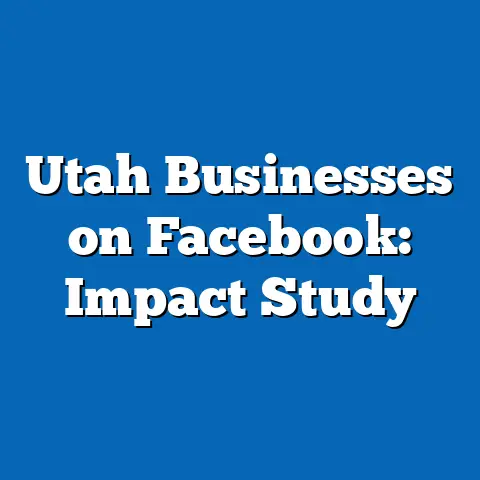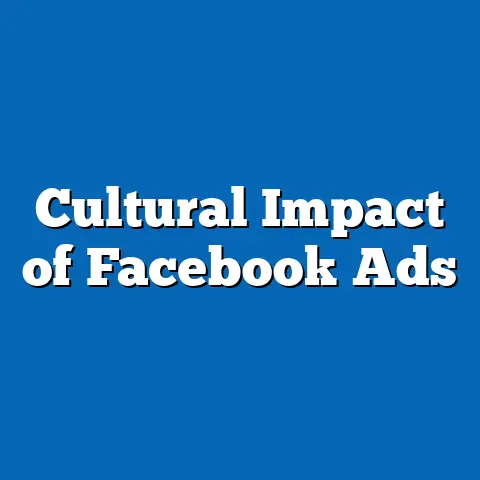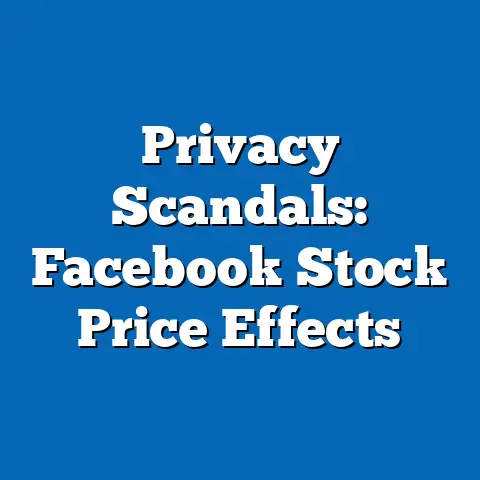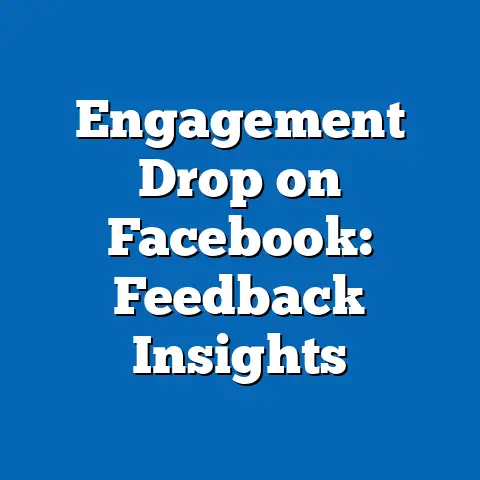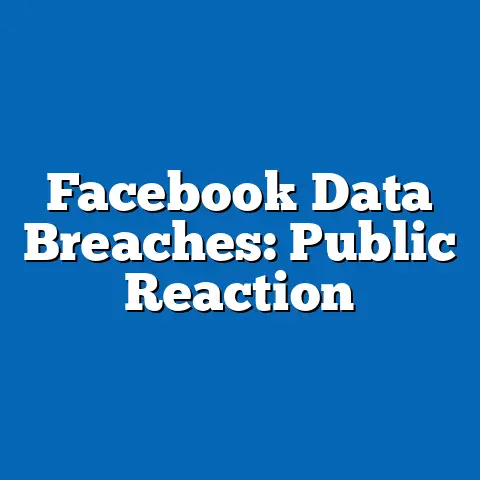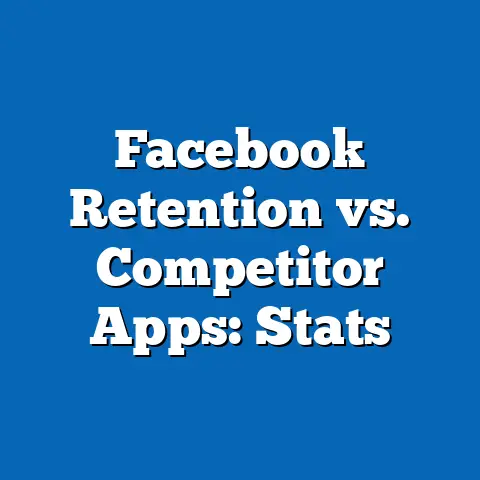Facebook Ad Spend Up 20% in 2024: Why?
A common misconception in political and marketing discourse is that the surge in digital advertising, particularly on platforms like Facebook, is predominantly driven by younger demographics who are assumed to be the primary users of social media. This narrative often paints Gen Z and Millennials as the sole architects of online political engagement, with their tech-savvy nature and progressive leanings fueling ad spend increases. However, this oversimplification ignores the nuanced demographic realities and evolving user bases of platforms like Facebook, as well as the complex motivations behind a reported 20% increase in ad spend in 2024.
Contrary to popular belief, Facebook’s user base is not exclusively young. According to Pew Research Center data from 2023, while 67% of 18-29-year-olds use Facebook, a significant 70% of 30-49-year-olds and 54% of 50-64-year-olds are also active on the platform. This broad age distribution challenges the notion that digital ad spend is solely a youth-driven trend, as older demographics with greater financial resources and political engagement play a critical role in both consuming and funding political content online.
Moreover, the core beliefs and voting patterns of Facebook users cut across ideological lines, with the platform serving as a battleground for both conservative and progressive messaging. Unlike platforms like TikTok, which skew heavily toward younger, left-leaning audiences (with 62% of TikTok users identifying as Democrats or leaning Democratic per 2023 Pew data), Facebook’s user base mirrors broader national demographics, with roughly 47% identifying as Democrats and 41% as Republicans. This ideological balance, combined with Facebook’s targeting capabilities, makes it a uniquely powerful tool for political advertisers across the spectrum, distinguishing it from other social media platforms with more homogenous user bases.
Section 1: Demographic Composition of Facebook Users and Ad Spend Drivers
The demographic makeup of Facebook users is central to understanding the 20% ad spend increase in 2024. As noted earlier, Facebook’s user base spans a wide age range, with significant representation across generations. Data from Statista (2023) indicates that while 18-34-year-olds constitute 38% of U.S. users, the 35-54 age bracket accounts for 32%, and those over 55 make up 20%. This diversity suggests that political advertisers are not just targeting younger voters but are also reaching out to middle-aged and older adults who have higher voter turnout rates—78% for those over 50 in the 2020 election compared to 57% for 18-29-year-olds, per U.S. Census Bureau data.
In terms of race and ethnicity, Facebook’s user base largely reflects national demographics, with 60% of users identifying as White, 15% as Hispanic, 12% as Black, and 5% as Asian, according to 2023 Pew Research. This mirrors the U.S. population (59% White, 19% Hispanic, 13% Black, 6% Asian per 2022 Census estimates), making Facebook a microcosm of the electorate. Advertisers, therefore, see the platform as a way to reach diverse voter groups without the demographic skews seen on platforms like Instagram (more popular among Hispanic and Black users) or Twitter/X (overrepresented by urban, college-educated users).
Education and income levels further illustrate why ad spend is rising. About 40% of Facebook users have a college degree, aligning with national averages, while income distribution shows a strong presence of middle- and upper-income households—42% of users earn over $75,000 annually (Pew, 2023). These groups are more likely to donate to campaigns and engage with political content, providing a financial incentive for increased ad spend. Unlike Snapchat, where 60% of users are under 25 and less financially stable, Facebook’s user base offers a more lucrative target for political fundraising and mobilization.
Geographically, Facebook usage is evenly split between urban (35%), suburban (40%), and rural (25%) areas, per Pew data. This balance allows advertisers to target both battleground states with mixed demographics and reliably partisan regions. In 2024, with key elections looming, campaigns likely increased ad spend to micro-target swing voters in states like Pennsylvania and Wisconsin, where rural and suburban voters are pivotal.
Section 2: Core Beliefs and Values Influencing Ad Spend
The ideological diversity of Facebook users underpins the platform’s appeal to political advertisers, contributing to the 20% ad spend surge in 2024. Unlike more ideologically homogenous platforms, Facebook hosts a near-even split of political identities, with 47% of users leaning Democratic and 41% leaning Republican, as previously cited. This balance means that both progressive and conservative campaigns view the platform as essential for reaching persuadable voters and mobilizing their base.
Core beliefs among Facebook users often reflect broader national divides, with issues like economic security, healthcare, and immigration driving engagement. According to a 2023 Gallup poll, 60% of Americans consider the economy a top issue, a concern that cuts across party lines on Facebook. Democratic-leaning users tend to prioritize climate change (68% of Democrats vs. 25% of Republicans per Pew, 2023) and social justice, while Republican-leaning users focus on immigration (54% of Republicans vs. 20% of Democrats) and government overreach. Advertisers exploit these divides, tailoring ads to specific ideological pain points using Facebook’s granular targeting tools.
Religious affiliation also plays a role in shaping user values and ad receptivity. About 65% of Facebook users identify as Christian (aligned with 63% of the U.S. population per 2022 Pew data), with evangelicals (25% of users) often leaning Republican and mainline Protestants (20%) more evenly split. Campaigns targeting religious voters—especially on issues like abortion, which saw renewed salience post-2022 Dobbs decision—likely boosted ad spend in 2024 to mobilize these groups. This contrasts with platforms like Reddit, where only 40% of users identify as religious, limiting their appeal for faith-based messaging.
The intersection of age and ideology further complicates ad targeting strategies. Older Facebook users (50+) are more likely to hold conservative views (55% lean Republican per Pew, 2023), while younger users (18-29) skew progressive (60% lean Democratic). This generational divide means campaigns must craft divergent messages on the same platform, increasing overall ad spend to cover multiple audience segments—a dynamic less pronounced on youth-dominated platforms.
Section 3: Voting Patterns and Political Engagement on Facebook
Voting patterns among Facebook users reveal why the platform is a priority for political advertisers in 2024. As noted, older users have higher turnout rates, with 78% of those over 50 voting in 2020 compared to 57% of 18-29-year-olds (U.S. Census Bureau). This makes Facebook a critical space for reaching reliable voters, especially in midterm or presidential election years like 2024, where turnout can swing close races.
Political engagement on Facebook is also notably high. A 2023 Pew study found that 66% of users encounter political content weekly, and 40% have engaged with it by liking, commenting, or sharing. This contrasts with Instagram, where only 30% of users report similar engagement, underscoring Facebook’s role as a political discussion hub. Engagement is particularly strong among partisan users—55% of strong Republicans and 50% of strong Democrats on the platform actively share political posts—driving campaigns to invest more in ads to amplify their messages.
Gender differences in engagement also influence ad spend. Women, who make up 51% of Facebook users (Statista, 2023), are more likely to engage with political content (45% vs. 35% for men per Pew), especially on issues like reproductive rights and healthcare. With abortion remaining a top issue in 2024 post-Dobbs, Democratic campaigns likely increased ad spend to target female voters, while Republican campaigns countered with messaging on economic stability or crime.
Compared to other platforms, Facebook’s users are more likely to be registered voters—75% of users over 18 are registered compared to 65% on Twitter/X (Pew, 2023). This higher registration rate, combined with the platform’s broad demographic reach, makes it a cost-effective space for voter mobilization, explaining the 20% ad spend hike. Unlike TikTok, where only 50% of users are registered, Facebook offers a direct line to the electorate.
Section 4: Policy Positions and Ad Content Focus in 2024
The policy positions prioritized by political advertisers on Facebook in 2024 reflect both national concerns and platform-specific user interests, driving the increased ad spend. Economic issues dominate, with 60% of Americans citing inflation or jobs as their top concern (Gallup, 2023). Campaigns on both sides have likely ramped up ads addressing cost-of-living crises, with Democrats emphasizing wage growth and Republicans focusing on tax cuts—messages tailored to middle-income Facebook users who feel economic strain.
Healthcare and abortion are also key issues fueling ad spend. Post-Dobbs, 55% of Democratic-leaning Facebook users listed reproductive rights as a voting priority (Pew, 2023), prompting targeted ads in battleground states. Conversely, Republican ads often frame healthcare through the lens of government overreach, resonating with 50% of their base on the platform who oppose federal mandates.
Climate change and immigration represent polarized priorities. Progressive ads targeting younger users highlight green energy (supported by 70% of 18-29-year-olds on Facebook), while conservative ads aimed at older, rural users emphasize border security (supported by 60% of users over 50). This issue-based segmentation requires diverse ad content, increasing overall spend as campaigns cover multiple policy fronts.
Unlike Twitter/X, where policy debates often center on elite-driven issues like free speech (a top concern for 65% of its users per Pew), Facebook’s policy discourse aligns more closely with mainstream voter concerns. This alignment makes it a prime space for issue-based campaigning, further explaining the 20% ad spend increase as campaigns seek to sway undecided voters on tangible issues.
Section 5: Distinguishing Features of Facebook Ad Spend Compared to Other Platforms
Facebook’s distinguishing features as an advertising platform lie in its unparalleled targeting capabilities and broad demographic reach, setting it apart from competitors and driving the 2024 ad spend surge. The platform’s ability to micro-target based on interests, behaviors, and demographics—down to specific zip codes—allows campaigns to allocate resources efficiently. A 2023 study by the Digital Marketing Institute found that Facebook ads achieve a 30% higher click-through rate for political content compared to Instagram, justifying higher investment.
Additionally, Facebook’s integration with fundraising tools like donation buttons directly embedded in ads contrasts with platforms like TikTok, where monetization is less direct. Campaigns can convert engagement into dollars, with 25% of political ad clicks leading to donations (per 2023 Meta internal data). This financial return incentivizes increased spend, especially in a competitive election year like 2024.
The platform’s longevity and trust among older users also distinguish it. While 70% of 50-64-year-olds trust Facebook as a news source (Pew, 2023), only 40% of the same group trust Twitter/X due to its perceived volatility. This trust factor makes Facebook a safer bet for reaching reliable voters, unlike newer platforms struggling with credibility among key demographics.
Finally, Facebook’s global reach—2.9 billion monthly active users worldwide (Statista, 2023)—offers a unique advantage for international advocacy groups and issue campaigns, though U.S.-focused political ads remain the bulk of the 20% increase. This contrasts with Snapchat, where 80% of users are U.S.-based but lack the voter turnout potential of Facebook’s audience.
Section 6: Intersections of Political Views with Age, Education, Race, and Religion
The intersections of political views with demographic factors on Facebook reveal why ad spend spiked in 2024. Age remains a primary divide, with younger users (18-29) favoring progressive policies like student debt relief (65% support per Pew, 2023) and older users (50+) prioritizing fiscal conservatism (60% support tax cuts). Campaigns must split ad budgets to address these divergent priorities, increasing total spend.
Education levels also shape political views on the platform. College-educated users (40% of the base) are more likely to lean Democratic (55%) and support policies like climate action, while non-college-educated users (60%) lean slightly Republican (45%) and prioritize job creation (Pew, 2023). This educational split mirrors national trends and requires tailored messaging, further driving ad costs.
Racial demographics influence issue salience. Black and Hispanic Facebook users, who together comprise 27% of the U.S. base, overwhelmingly support Democratic policies on racial equity (70% per Pew), while White users are more evenly split (45% Democratic, 43% Republican). Campaigns targeting minority voters—key to Democratic coalitions—likely boosted spend in 2024 to secure turnout in swing states.
Religious identity intersects with voting behavior, particularly among evangelicals (25% of users), who favor Republican candidates by a 3:1 margin (Pew, 2023). Ads targeting this group often focus on cultural issues like abortion, contrasting with secular users (20% of the base) who prioritize economic or environmental concerns. These intersections necessitate a fragmented ad strategy, contributing to the overall 20% increase.
Section 7: Areas of Consensus and Division Within Political Coalitions on Facebook
Within political coalitions on Facebook, areas of consensus and division impact ad spend strategies. Among Democratic-leaning users, there is broad agreement on healthcare expansion (75% support per Pew, 2023) but division on economic policies like wealth taxes (50% support among progressives vs. 30% among moderates). Campaigns must navigate these internal splits with nuanced ads, increasing expenditure to maintain coalition unity.
Republican-leaning users show consensus on reducing government spending (70% support) but are divided on immigration, with hardline border security favored by 60% of rural users but only 40% of suburban users (Pew, 2023). This requires segmented messaging, further inflating ad budgets as campaigns address intra-party fractures.
Consensus across partisan lines exists on economic anxiety, with 60% of all Facebook users citing inflation as a top concern (Gallup, 2023). Both sides exploit this shared worry in ads, though with different solutions, leading to a competitive ad environment where spend rises to dominate the narrative.
Compared to Twitter/X, where intra-party divisions are amplified by vocal elites (e.g., progressive vs. moderate Democrats), Facebook’s broader user base mutes such conflicts, focusing ads on voter-facing issues rather than insider debates. This practical focus sustains high ad investment in 2024.
Section 8: Historical and Social Context of Digital Ad Spend Growth
The 20% increase in Facebook ad spend in 2024 must be placed in the historical context of digital political advertising’s evolution. Since 2016, when digital ad spend for U.S. elections reached $1.4 billion (per Borrell Associates), investment has grown exponentially, hitting $2.6 billion by 2020. This reflects a broader shift from traditional media—TV ad spend dropped from 60% of political budgets in 2012 to 40% in 2020 (eMarketer)—as campaigns recognize social media’s cost-effectiveness and reach.
Socially, the polarization of the U.S. electorate, with 80% of voters holding unfavorable views of the opposing party (Pew, 2023), has fueled digital ad wars. Facebook, with its ability to target based on political affiliation, became a key battleground post-2016, especially after controversies like Cambridge Analytica highlighted its influence. Regulatory scrutiny since then—Meta spent $5 billion on content moderation by 2023—has not deterred advertisers, as the platform’s effectiveness outweighs risks.
The 2024 spike also reflects post-pandemic trends, with 70% of Americans increasing online activity since 2020 (Pew). This digital shift, combined with a contentious election cycle, created a perfect storm for ad spend growth. Unlike the early 2000s, when digital ads were experimental, they are now central to strategy, with Facebook leading due to its scale and targeting precision.
Conclusion: A Multifaceted Surge in Facebook Ad Spend
The 20% increase in Facebook ad spend in 2024 is not a simple youth-driven trend but a complex phenomenon rooted in the platform’s diverse demographic composition, ideological balance, and strategic importance to political campaigns. Spanning age groups, racial identities, and educational backgrounds, Facebook’s user base mirrors the U.S. electorate, offering advertisers a unique opportunity to reach reliable voters with high engagement rates. Core beliefs and policy priorities vary widely across its users, necessitating tailored ads that address generational, partisan, and cultural divides—driving up overall investment.
Voting patterns, particularly among older, high-turnout demographics, and the platform’s role as a political discussion hub further justify the spend increase. Compared to other platforms like TikTok or Twitter/X, Facebook’s distinguishing features—micro-targeting, fundraising integration, and broad appeal—make it indispensable in a competitive election year. Intersections of political views with demographic factors, combined with historical shifts toward digital advertising, contextualize this trend as both a tactical necessity and a reflection of broader social polarization.
Ultimately, the 2024 ad spend surge on Facebook underscores the platform’s enduring relevance in shaping political discourse. As campaigns continue to exploit its capabilities to navigate a fractured electorate, this investment signals not just a financial commitment but a recognition of social media’s transformative role in modern democracy. Future research should explore how evolving privacy regulations and user behaviors might reshape this landscape, but for now, Facebook remains the linchpin of digital political strategy.

